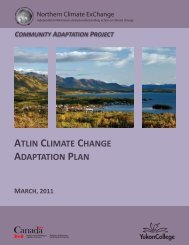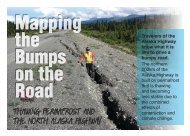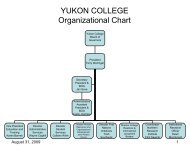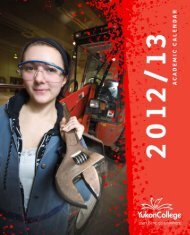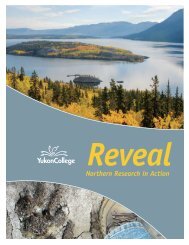Dawson Climate Change Adaptation Plan, Revised ... - Yukon College
Dawson Climate Change Adaptation Plan, Revised ... - Yukon College
Dawson Climate Change Adaptation Plan, Revised ... - Yukon College
You also want an ePaper? Increase the reach of your titles
YUMPU automatically turns print PDFs into web optimized ePapers that Google loves.
Community <strong>Adaptation</strong> Projectconditions. For the benefit of exploring the spatial variation in climate change, run 4 from theCRCM4 with the A2 emissions scenario was provided (i.e., if no change occurs to our globalconsumption of fossil fuels). Results are presented by comparing the changes from the 1961-1990 baseline for the 2050s (2041-2070) (see Werner et al., 2008).The projection data presented in this section must be qualified. The CRCM model used toproduce the projected climate-change maps (see Werner et al., 2008) is driven by the CGCM3,which tends to have warmer, wetter conditions when compared to other GCM models. Thereis also greater uncertainty with precipitation projections than temperature projections due tothe large variability in precipitation over space and in time (Werner et al., 2008). Informationto support these projections is currently limited and the need to improve the uncertaintyassociated with climate change projections is ongoing.Anticipated Temperature 2041-2070A relatively uniform increase in annual temperature of 2.5 o C to 3.5 o C is projected for the 30-yeartime period (2041-2070) of the 2050s (Werner et al., 2008). These projections fall within therange of 2.1 o C to 3.5 o C given by the 25 th and 75 th percentiles from 15 GCMs (Werner et al., 2008).Winter is expected to experience the greatest extent of warming of between 4 o C and 6 o C(Werner et al., 2008). These are some of the largest projected increases in temperature forwestern North America (Rodenhuis et al., 2007). Summer warming is projected to be between1.5 o C and 2.5 o C (Werner et al., 2008). For the most part, the CRCM projections fall within thoseprovided for the area by the 15 GCMS driven by two emissions scenarios A2 and B1. The CRCMwinter projections are slightly greater than the maximum projections for the GCM models of5.3 o C (Werner et al., 2008).Anticipated Annual Precipitation 2041-2070Annual precipitation in the <strong>Dawson</strong> region is projected to increase by 10% to 40%, and drierconditions are expected to occur to the north and east of <strong>Dawson</strong> City (Werner et al., 2008).Increases in precipitation are projected to be higher in winter than in summer. A 30% to 50%increase in winter precipitation is projected (Werner et al., 2008). An increase of only 10% to30% is projected for the summer months (Werner et al., 2008).While drought conditions are not currently projected, drought may be a potential vulnerabilityif precipitation does not increase sufficiently to match increasing temperatures. Under thesecircumstances, drought would result from increased evaporation, which would dry out thelandscape (ACIA, 2005). Drought conditions may be exacerbated by the projected increases inpotential evapotranspiration, which may result in water-stressed vegetation (ACIA, 2005).DAWSON COMMUNITY IMPACTS SCENARIOThe following climate change impacts scenario was developed in collaboration with <strong>Dawson</strong>residents based on the regional climate projections provided by PCIC (see Werner et al., 2008)at a Community Input Week held in November 2008. The scenario identifies how possibleclimate changes may create vulnerabilities in the community. To best reflect community input,the scenario is reported in full. The evaluation of possible consequences and the risks they maypose to the community is presented in the following section. Of the eleven climate-changevulnerabilities identified by the community, five affected the landscape and six affected residentsdirectly. Some community vulnerability stemmed from natural sources and evolving landscapeconditions, such as forest fire conditions. Other vulnerabilities emerged as a result of naturalforcing on human systems, specifically on the infrastructure or socio-economic conditions in22




